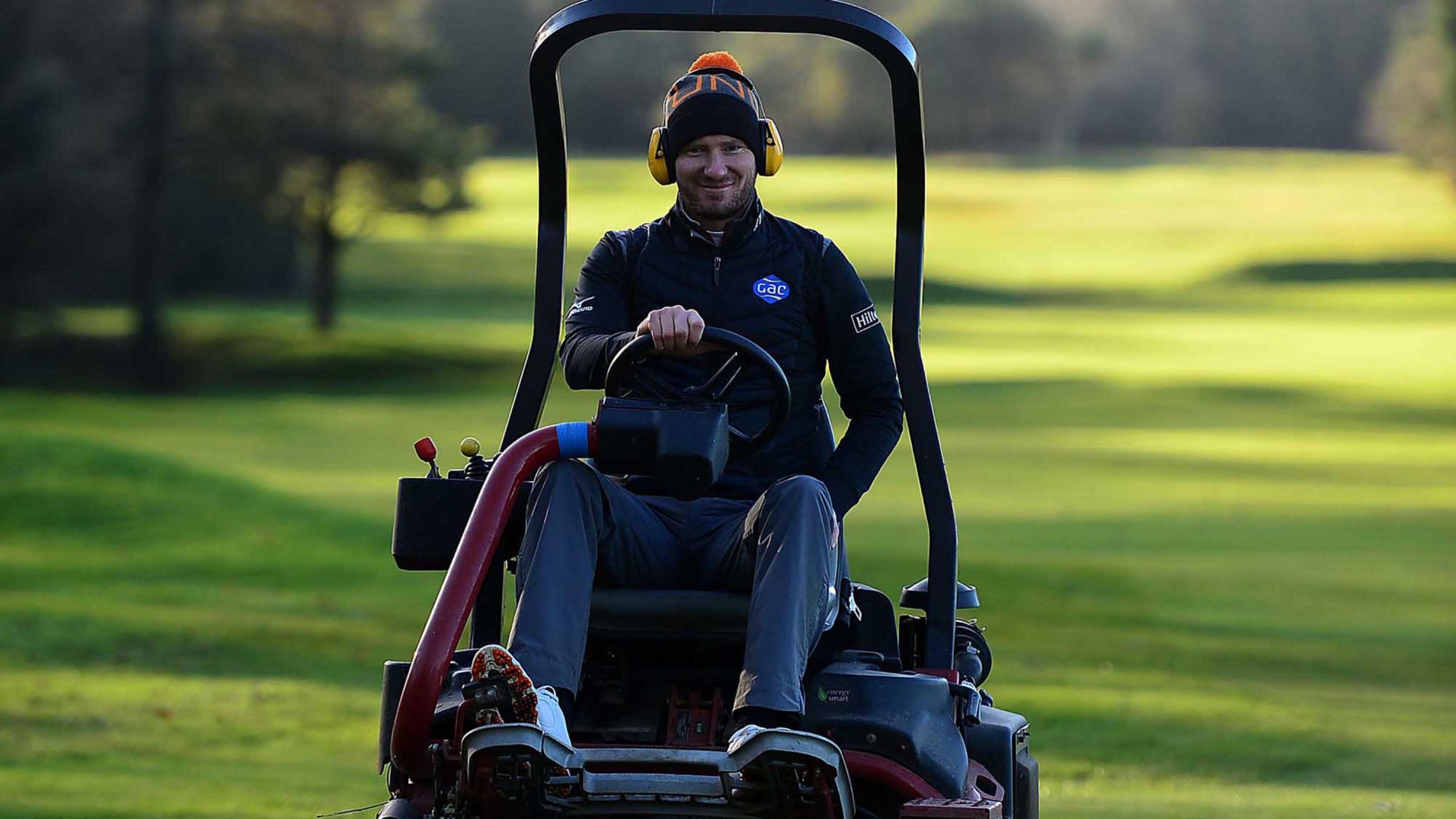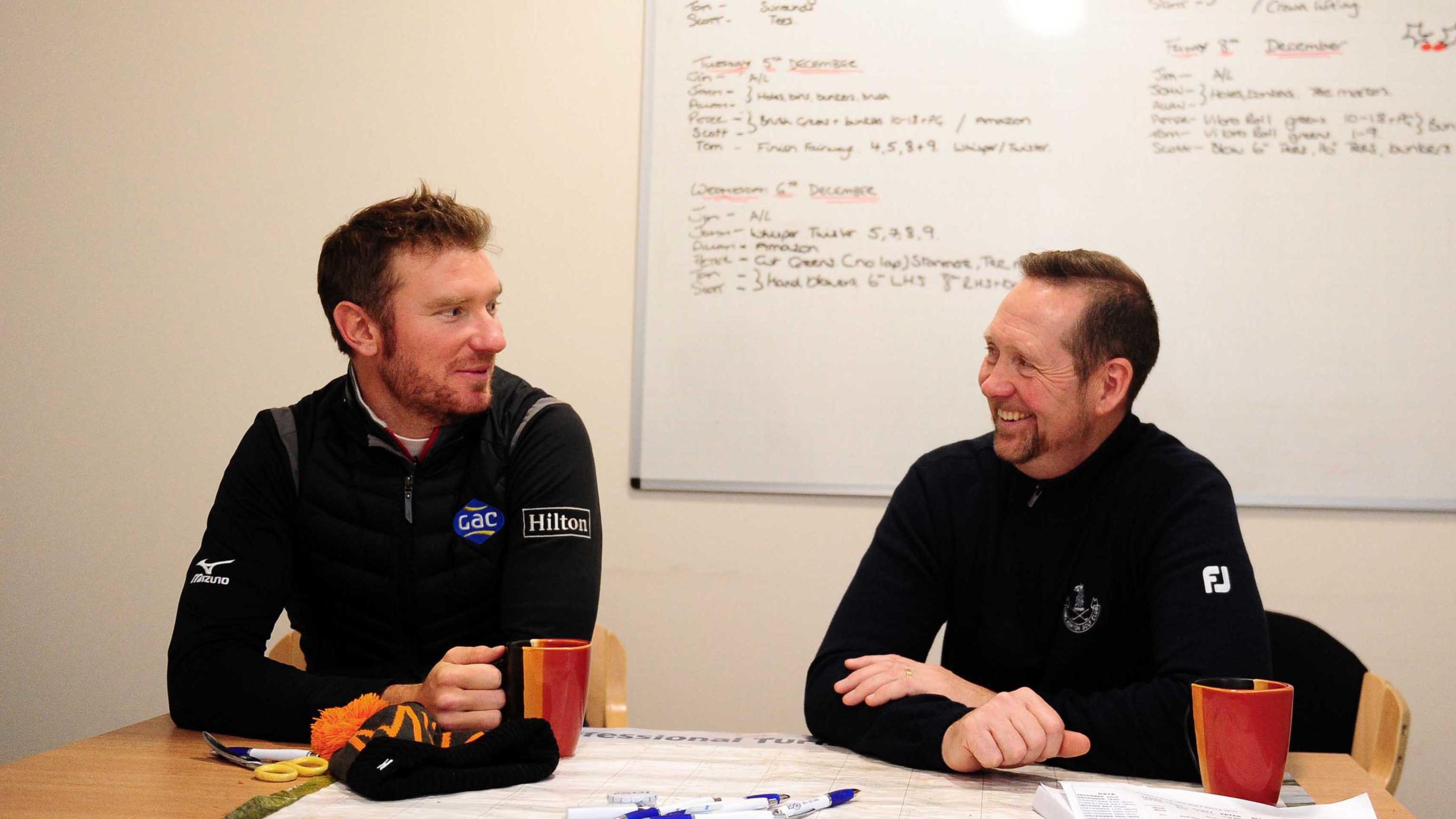- Homepage
- News and Features
- Chris Wood tells us why he's a fan of greenkeepers
Chris Wood tells us why he's a fan of greenkeepers

Ryder Cup player, three-time European Tour winner and proud member of Long Ashton, Chris Wood explains why he’s a big fan of the greenkeeping fraternity.
Life on the European Tour and your home club on the outskirts of Bristol must seem poles apart – but Chris Wood has never forgotten his roots.
The Ryder Cup player joined Long Ashton at the age of 10. His dad was a member before him, he did his work experience there as a teenager, he still uses the club for practice and he is now a life member.
Chris is quick to point out the huge role that the club has played in his development and is equally ready to point out the efforts of the greenkeeping staff there – and, in fact, all greenkeepers around the globe.
In short, the 6’ 6” former BMW PGA Championship winner gets it. He’s not got even slightly carried away by himself and all the successes that he’s had, instead retaining a close connection to the course where it all began.
We spent a day with Chris and Long Ashton’s course manager James Braithwaite to get the tour star’s hands dirty and hear his views on the world of the British greenkeeper, the way courses are set up on tour, and how the latter can often lead to unreasonable expectations of the former.
Your work experience while at school involved working as a greenkeeper. How did that go?
I was about 14 and you get asked at school what you want to do career-wise. I said something to do with golf so I had one week practising and playing and the other spent working with the greenkeepers at Long Ashton.
I was in at 6am and out working on the course and I really enjoyed it. They were building some steps up to the 17th tee so every time I’m there I think of that week.
I always had an interest in how a course is managed and, when you played as much golf as I did as a junior, you get to know all the greenkeepers at the club pretty well. It’s been the same guys pretty much since I joined when I was 10.
You either love being outdoors or you don’t and I think if I hadn’t made it as a golfer, I’d have been a pretty decent greenkeeper. Being from the West Country, I’m quite comfortable on a tractor.
What do you like to see on a course?
I’m a big fan of stripes down a fairway. Even my garden has some nice stripes.
Do you have any early memories of going to a tour event and being enamoured by the look of the course?
A memory of mine was at Wentworth when I was about 14 and, when you cross the fairway and look down the hole, you would think to yourself ‘oh my god’ and that was a big incentive to make it on to the tour. I would always picture myself hitting a wedge off that type of fairway.
On tour you get used to things being impeccable and we are very spoilt. In Europe I would say we are slightly behind the standard in the States but that is down to time, money and staff. They have all these big resorts with these million-dollar houses around it, so they can afford to have up to maybe 30 members of staff.
Here at Long Ashton we have five or six on the greenkeeping staff, which is about average – some 18-hole courses have to manage with even less!
Greenkeepers generally get a lot of criticism for hollow tining the greens or putting temporary greens in play. How knowledgeable do you think the average club member is?
When you have 700 members you cannot please everyone and the more I’ve got to know James, the more I’ve got to understand his frustrations.
I would say the average golfer’s knowledge is no better than about two out of 10.
The problem in the UK is that everyone watches the Masters in April and the course there is absolutely immaculate. I have played in three Masters and there really isn’t a weed on the course.
Everyone thinks the Masters marks the start of British summertime and the start of the golf season but it isn’t really, it’s still bloody cold. They’ve not had any growth and, in truth, it is probably time for a bit of course work. So everyone has a late Sunday night watching Augusta and turns up to their club the following weekend and the greens have been hollow tined and it is a long way from what they’ve seen on the TV.
It is all about understanding that a course in the UK will be in its prime from June to maybe October. But you have to realise that you are going to get five months of decent conditions and the rest will be a bit of a struggle.
Members’ perceptions can include the greenkeepers doing the greens, raking the bunkers and being back in their cars by 9am. Is that fair enough?
I think some do think like that, yes. Our lads have their coffee break at 11am after they have already done five hours and they won’t finish until maybe one or two o’clock. I have sat down with them on their break and they come in from all corners of the course.
If you are teeing off at 9am it would be quite easy to miss them. The lads might be two holes ahead and then jump across to another part of the course.
How do you make your practice work here at Long Ashton to prepare yourself for a European Tour event?
We are spoilt on tour, where the greens are hand cut. I have asked whether that would be possible (at Long Ashton), but obviously it’s not with the limitations on time and money. In the summer I will spend four or five hours on the putting green so I will send James a text and he will roll and double cut it for me, which gives a lot of members a shock when they get on there and all the putts are rolling three feet past! All of a sudden, I can practise putts that are 12 on the Stimpmeter rather than eight or nine – he doesn’t have to do that and it takes around 40 minutes to do so, so it really is a big help to me.
What is the best conditioned course on tour?
In the Middle East it is fantastic, you cannot fault them and the greens are just phenomenal. Also, most of us are coming out from Europe, so you get to Abu Dhabi and you think it is even more unreal.
A lot is down to the tournament itself. Over the years they might have changed hands promoter-wise and they might not have as much money as before so the standard will drop a bit but it is still to a high enough level.
That said you will still get 50 per cent of the field having a good moan!
Did you prefer the course side of it as an amateur rather than as a tour pro?
If you got into the England set-up then you would be sent off all round the world as amateurs. I went to places like Argentina, Russia, Australia, Mexico and that really does set you up for being a professional.
Then you play the Lytham Trophy, that was one of the first events of the year and it was always brutal. You would be stood on the 1st tee with a 3-iron in your hand with the wind into and off the left. I don’t think I have ever hit it on the railway, touch wood. Then the next two are the same.
The South of England was at Walton Heath, the British Amateur was always amazing, then you had the St Andrews Links Trophy. You are forever on world-class courses and all these Open venues. I think that had a lot to do with me getting on the tour and staying there.
This article was first published in Your Course, the twice-yearly magazine from the British & International Golf Greenkeepers Association that aims to inform golfers about what goes in to the maintenance of a modern golf course and the greenkeepers whose job it is to produce the surfaces.

James Braithwaite, course manager at Long Ashton, is firm friends with Chris Wood. He explained why he’s thrilled that Wood is championing the cause of greenkeepers
“I’m really delighted that Chris has agreed to champion the cause of greenkeepers everywhere,” said James. “For years BIGGA and the association’s members have been shouting about the professionalism and passion of those within the industry.
“However, without being too derogatory towards certain aspects of the golf industry, from my personal point of view, there’s only two types of people golfers will listen to; one’s the R&A and the other is professional golfers.
“BIGGA is seen as greenkeepers working for greenkeepers, so we are biased. We need other people to get involved to champion our cause.”
Once flippantly thought of as mere grass cutters by golfers, the modern greenkeeper must work hard to have his voice heard within the clubhouse.
In improving communication channels between the greenkeeping team and the committee structure and membership, there is a belief that a better understanding of what goes into the production and presentation of the golf course will help to ease the pressure on greenkeepers, who find themselves under scrutiny with sometimes unreasonable, and yet completely avoidable, pressure.
James added: “I spoke to Chris about how we are losing a lot of talented greenkeepers from the industry because of pressure from above.
“Expectations have gone up phenomenally within the past 10 years. For example, (around Bristol) we have 15 golf courses within a 10-mile area and the competition is immense, so the expectation of the standard they want to play on is higher.
“They see perfect golf on the television week in, week out, but it’s not a practical scenario to have six to eight months of the year.
“I will to talk to people and they will always say ‘I didn’t realise there was that much that goes into a course’. The sad thing is they still think we are just grass cutters.
“They don’t understand we are educated professionals with years of training underneath our belts.
“My guys are well educated and we are always looking to improve, with new techniques and new machinery,
“We do a weekly update to members and a report to the committee about what’s going on around the course. I do open forum presentations. It was one of these presentations that I did four years ago that convinced the committee that we needed to redo our greens.
“But there’s still the problem of the lack of knowledge about what we do, and I hope that more people like Chris will get on board and champion the work of the nation’s hard-working, educated and passionate greenkeepers.”
So, when you’re out at 8am and you don’t see a greenkeeper for the first nine holes, the likelihood is that they are working away on the back nine so as not to interfere with your day out or, even more likely, they have been working away since 6am and the front nine ha already been tended to.
This article was first published in Your Course, the twice-yearly magazine from the British & International Golf Greenkeepers Association that aims to inform golfers about what goes in to the maintenance of a modern golf course and the greenkeepers whose job it is to produce the surfaces.
Author

